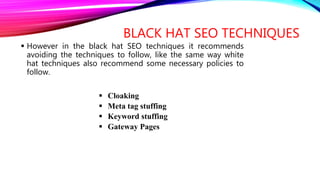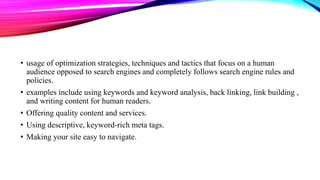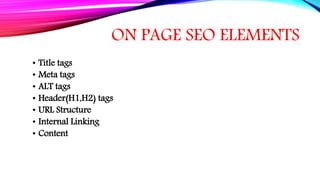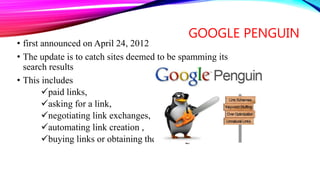Basics of seo
- 1. BASICS OF SEO& GOOGLE UPDATES
- 2. WHAT IS SEO SEO is an abbreviation for search engine optimization. SEO is the process of improving the volume or quality of traffic to a web site from search engines via search results. SEO aims to improve rankings for relevant keywords in search results
- 3. GOALS OF SEO •Acquire Top Place on the search engines • Boost sales and Increase return on investment • Expand customer base and target audience • Growth in website visitors
- 5. BLACK HAT SEO TECHNIQUES However in the black hat SEO techniques it recommends avoiding the techniques to follow, like the same way white hat techniques also recommend some necessary policies to follow. Cloaking Meta tag stuffing Keyword stuffing Gateway Pages
- 6. CLOAKING • It is a process of creating some different version of same web pages to make different users visible on their views like mobile phones, tablets, computers and laptops etc…It gives entirely different displays, so it is called as cloaking
- 7. META TAG STUFFING • In normally meta-tag keywords are using on the web pages related to the purpose of good SEO tactics. But if you using many times that particular meta-tag keyword means are referred as keyword stuffing
- 8. GATEWAY PAGES • It is referred as the website consist number of keyword instead of more contents. They will fill the pages by using the same words again and again
- 9. KEYWORD STUFFING • It is also same as Meta tag stuffing; it is a process of using more times of a particular keyword to make your site at a top position.
- 10. WHITE HAT SEO
- 11. • usage of optimization strategies, techniques and tactics that focus on a human audience opposed to search engines and completely follows search engine rules and policies. • examples include using keywords and keyword analysis, back linking, link building , and writing content for human readers. • Offering quality content and services. • Using descriptive, keyword-rich meta tags. • Making your site easy to navigate.
- 12. WHITE HAT SEO VS BLACK HAT SEO GRAPH
- 13. PROCESS OF SEO 1.Off Page Optimization 2.On Page Optimization
- 15. OFF PAGE OPTIMIZATION: •Off Page is a way to build relevant back links to the website by using best suited anchor text. Back links has their own importance for Google to generate traffic to the website.
- 16. OFF PAGE SEO INCLUDES:- Blog Submission Directory Submission Social Bookmarking Classifieds Submission
- 17. ON PAGE SEO ELEMENTS • Title tags • Meta tags • ALT tags • Header(H1,H2) tags • URL Structure • Internal Linking • Content
- 18. TITLE• Use targeted keywords/phrase towards the beginning of Title tag. • No spelling and grammatical mistake. • Keep length limit to 50 - 60 Characters only with spaces.
- 19. HEADING TAGS • Use heading tags like h2, h3 and h4 to highlight various headings, sub- headings and important points. don’t repeat H2 or H3 tags too many times, as it is considered as negative SEO practice.
- 20. URL • Aim at using targeted keywords towards the beginning of blog post URL. • Avoid using special characters, symbols, brackets, comma’s etc as part of your post URL
- 21. META TAGS • Add unique & relevant meta keyword . • Use your targeted keyword in the meta tags • limit the length to 155 - 160 characters.
- 22. IMAGES Image optimization helps a lot in driving traffic from image search. • Keyword in alt text in image & image title helps a lot to make your blog post more focus and targeted. • Keep small size images than larger images to avoid slow down of your blog speed as Google considers website speed as one of rankings factor on Google organic search.
- 23. INTERNAL LINKING • links that go from one page on a domain to a different page on the same domain. They are commonly used in main navigation. These type of links are useful for three reasons: They allow users to navigate a website.
- 25. IMPORTANT GOOGLE ALGORITHM UPDATES • Google Panda Update • Google Penguin Update • Google Pirate Update • Google EMD (Exact Match Domain) Update • Google Hummingbird • Rank Brain Update • Google Payday Update • Google Pigeon Update • Google Mobile Friendly Update
- 27. GOOGLE PANDA • search filter introduced in February 2011. • Also called farmer update • Low quality content • Poor content • copy paste • Grammatical error • Spelling mistake
- 28. GOOGLE PENGUIN • first announced on April 24, 2012 • The update is to catch sites deemed to be spamming its search results • This includes paid links, asking for a link, negotiating link exchanges, automating link creation , buying links or obtaining them through link networks .
- 29. GOOGLE PIRATE UPDATE • introduced in August 2012. • Designed to prevent sites with many copyright infringement reports, as filed through Google’s DMCA system, from ranking well in Google’s listings
- 30. GOOGLE EMD (EXACT MATCH DOMAIN) UPDATE • Google launched in September 2012 • to prevent poor quality sites from ranking. • Simply because they had words that match search terms in their domain names
- 32. GOOGLE HUMMINGBIRD • Introduced in September 2013. • Hummingbird is paying more attention to each word in a query, ensuring the whole query — the whole sentence or conversation or meaning — is taken into account, rather than particular words. • It is a new search platform as the name means “precise and fast” is developed in a way to give a semantic search result. • It act as a personal assistant & knowledge Graph provides gives a better result.
- 33. RANK BRAIN • Rank Brain is an artificial intelligence (AI) program used to help process Google search queries. • If Rank Brain sees a word or phrase it isn’t familiar with, the machine can make a guess as to what words or phrases might have a similar meaning and filter the result
- 34. GOOGLE PIGEON UPDATE • Launched on July 24, 2014 • The Pigeon Update is a new algorithm to provide more useful, relevant and accurate local search results. • This is quite useful for the user and the local business
- 36. PAYDAY LOAN UPDATE • Introduced in June 2013 • This algorithm is targeted to remove the spammy queries • This update, which was designed to combat specific search queries that tend to have a high number of extremely spammy results was launched in June 11, 2013
- 37. GOOGLE MOBILE-FRIENDLY UPDATE • On April 21 2015 • boost to mobile-friendly pages in Google’s mobile search results • Its text has to be readable without tapping and zooming
- 38. By Aneena Binoy





































